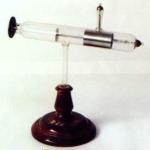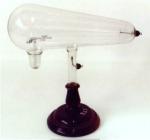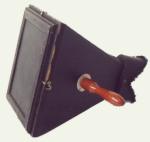

 Menu
Menu
|
Function To study the electric discharges in a low pressure environment. |

| ||
|
|||
|
Description It has a spherical form with four electrodes and a shining wooden foot. With the apparatus we can verify that the discharge happens following the shortest way between the two points of the current connection. | |||
 Menu
Menu
|
Function To study the action of the magnetic fields on the cathode rays. |

| ||
|
|||
|
Description It contains a cathode at the thinner end, a metallic diaphragm with a central circular opening, and a thin mica layer covered with a fluorescent substance at the wider end. When it works, the beam of cathode rays that crosses the diaphragm, provokes the fluorescence on a small part of the mica disk, aligned with the cathode and the diaphragm hole. This demonstrates that the cathode rays go in a straight line from the cathode to the screen. If we approach a magnet between the diaphragm and the screen, the fluorescent spot moves. This demonstrates that the cathode rays are deviated by a magnetic field, and they behave as negative charged particles with great speed. | |||
|
Function To study the action of the cathode rays in the electric and magnetic fields. |

| ||
|
|||
|
Description It is similar to Braunís tube, but it has also a capacitor with parallel plates. If we can set an electric field between the armatures, the spot on the screen moves from its initial position. The electrons deviate towards the plate with the highest potential. The tube can serve to determinate the speed of the cathode rays and the ration between an electron charge and its mass. | |||
|
Function To show the electric conduction in rarefied gases. |

|
||
|
|||
 Menu
Menu
|
Function To show the electric conduction in rarefied gases. |

| ||
|
|||
|
Description The tube shows three branches in the central part. The electrodes are placed on two of these, while the third is used to link it to a pneumatic pump. | |||
|
Function To show the electric conduction in rarefied gases. |

| ||
|
|||
|
Description It is formed by a glass tube, with two electrodes at the ends. The vacuum is obtained by linking the tube to a pneumatic pump. | |||
|
Function To show the rectilinear motion of the electrons. |

| ||
|
|||
|
Description Along the trajectory of the electrons of a divergent beam we place an obstacle with the form of a Malta cross whose shadow we can see on the fluorescent screen. | |||
|
Function To show that the bodies are transparent to x-rays. |

| ||
|
|||
|
Description The x-rays produced by this tube have a great penetration power and show clearly a hand and the wrist bones or the coin contained in a bag. | |||
|
Function To individuate the bodies crossed by x-rays. |

| ||
|
|||
|
Description It is formed by a fluorescent screen placed on a pyramidal case with handle. | |||